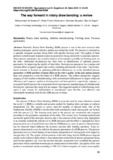Citation link:
http://dx.doi.org/10.25819/ubsi/10394Files in This Item:
| File | Description | Size | Format | |
|---|---|---|---|---|
| Kaleem_The_way_forward.pdf | 1.36 MB | Adobe PDF |  View/Open |
| Dokument Type: | InProceedings | metadata.dc.title: | The way forward in rotary draw bending: a review | Authors: | Kaleem, Muhammad Ali Frohn-Sörensen, Peter Geueke, Michael Engel, Bernd |
Institute: | Institut für Produktionstechnik | Free keywords: | Rotary draw bending, Additive manufacturing, Forming tools, Process parameters | Dewey Decimal Classification: | 620 Ingenieurwissenschaften und zugeordnete Tätigkeiten | GHBS-Clases: | ZIR | Issue Date: | 2023 | Publish Date: | 2023 | Source: | Engel, Bernd (Hrsg.): Transformation in der Biegetechnik : Tagungsband zum 6. Biegeforum Siegen : 24.-31. März 2023. Siegen: universi - Universitätsverlag Siegen, 2023. - ISBN 978-3-96182-155-6 - DOI http://dx.doi.org/10.25819/ubsi/10365, S. 53-63 | Abstract: | Presently, Rotary Draw Bending (RDB) process is one of the most common tube bending techniques used in industrial production around the world. The process is executed on a specially designed machine being fitted with specific forming tools. The quality of final products in RDB largely depends on process parameters being selected by the machine operator. These process parameters are selective balance of movements and effect of forming tools on the tubes. Substantial development has been done in identification of optimum process parameters for improving the quality of bent tubes. Each process parameter has a unique and versatile effect on quality aspects like ovality, wrinkling and fracture of the tubes. This reviewbased research is focused on gathering published information on so-far identified process parameters in RDB and their eventual effect on the tube’s quality. In the end, authors present their own perspective about the future of a RDB process. The authors perspective suggests merging of AM (Additive Manufacturing) with conventional RDB process to impart enhanced efficiency and improved quality to forming tools and bent products respectively. Apropos, a concept of hybrid pressure die is presented which encompasses manufacturing of a fundamental forming tool (pressure die) using AM techniques. The suggested model of hybrid forming tools opens a new avenue for industrialists to manufacture more flexible, cost effective and substantially beneficial tools for the RDB process in future. |
DOI: | http://dx.doi.org/10.25819/ubsi/10394 | URN: | urn:nbn:de:hbz:467-26065 | URI: | https://dspace.ub.uni-siegen.de/handle/ubsi/2606 | License: | http://creativecommons.org/licenses/by-sa/4.0/ |
| Appears in Collections: | Universi |
This item is protected by original copyright |
Page view(s)
223
checked on Nov 21, 2024
Download(s)
110
checked on Nov 21, 2024
Google ScholarTM
Check
Altmetric
This item is licensed under a Creative Commons License


